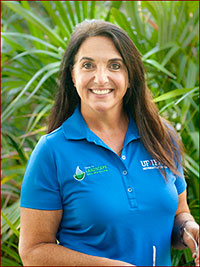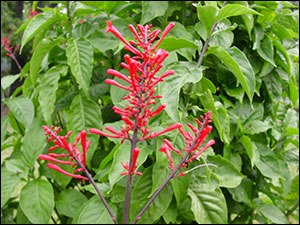Wendy's Wanderings
March 12, 2020
Made in the Shade
The days are longer and the sun is shining here in the Sunshine State. For those gardeners with a sunny yard the grass is greening and the flowers are popping. But if you have a shady yard or a shady spot in the landscape you may feel a little green with envy. Covet not shade gardeners, your shade is a desirable condition in our Florida yards — remember what that August sun feels like. If your yard has shady spots you can still create a beautiful and Florida-Friendly landscape.
So what are some great shade-loving plants to turn that bare patch in to a beautiful shaded retreat? As good gardeners, we know it always comes down to putting the right plant in the right place.
For groundcovers think about our native ferns, or our stand-out for dry shade: the cast iron plant (Aspidistra elatior). Consider also bromeliads to give a dramatic look with colorful foliage and stunning blooms. Native peperomia (Peperomia obtusifolia) grows beautifully in shady South Florida gardens too. A border or mass planting of leriope or mondo grass can pull the whole look together.

Firespike attracts butterflies.
Shrubs that love shade include native azaleas, Florida anise, creeping yew (Cephalotaxus harringtonia) and the fragrant banana shrub. Use palms for that true Florida tropical look. Palms that love the shade include the native needle palm, bluestem palmetto (Sabal minor), and for bright shade in South Florida, the Florida silver palm (Coccothrinax argentata). I would be remiss not to mention that our native cycad Zamia pumila, the coontie, performs well in shade (and sun), and in some areas is a host plant for the coontie hair streak butterfly.
For color and blooms in the shade rely on our favorites, azaleas, camellias, and hydrangeas, but don't forget the many gingers that bloom so well in Florida. The red-blooming firespike grows easily and can attract butterflies in light shade. Our native beautyberry produces eye-catching magenta berries in the fall, and the low-growing native rouge plant (Rivina humilis) produces shiny red berries that the wildlife love. In frost freeze zones there are many different types of begonias that are favored for their attractive leaves and blooms. The leopard plant (Fargugium japonicum), with its big round leaves, grows best in the shade and gives daisy-like flowers in the fall. For tall white blooms try the oakleaf hydrangea; they are native and flower in the late spring and early summer.
Soil preparation can be a challenge in shaded areas because there will typically be roots from the trees providing the shade. You may want to try to dig a few exploratory holes before you design your garden and head to the garden center.
There are many great plants that grow beautifully in the shade, so do your research and put the right plant in the right place, and hopefully the shade garden you create this spring will be enjoyed in the heat of summer.
-- Wendy Wilber

